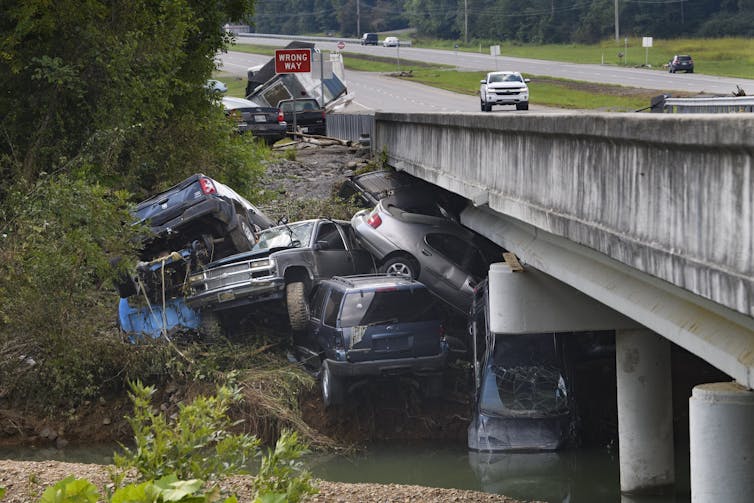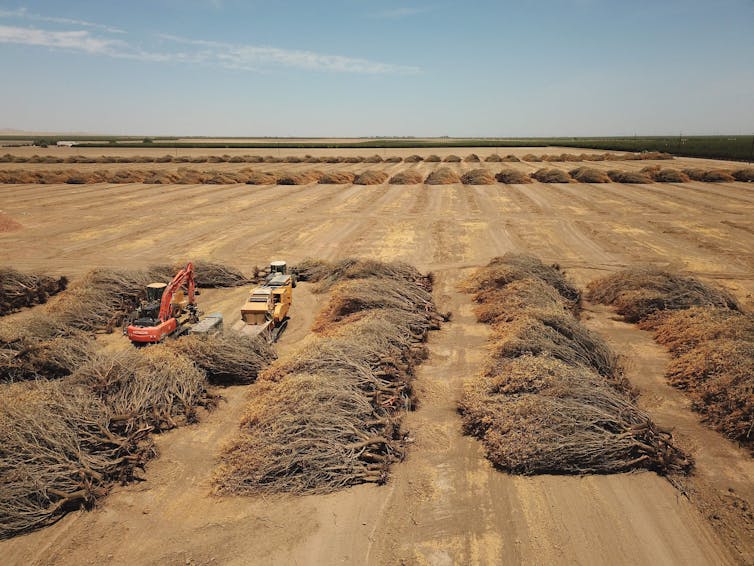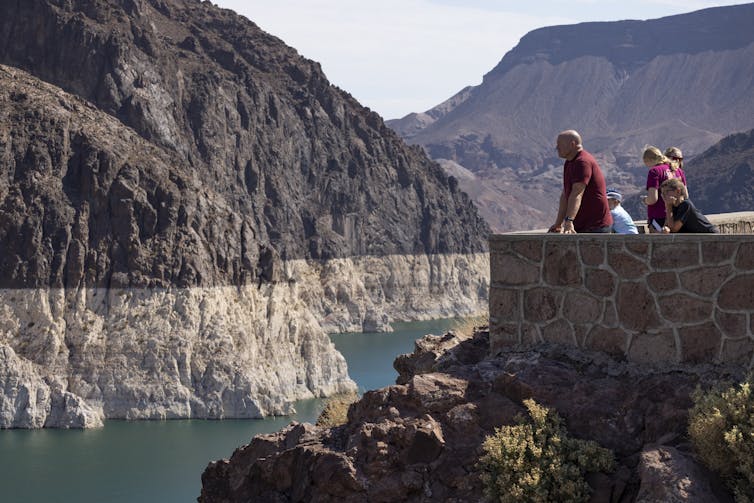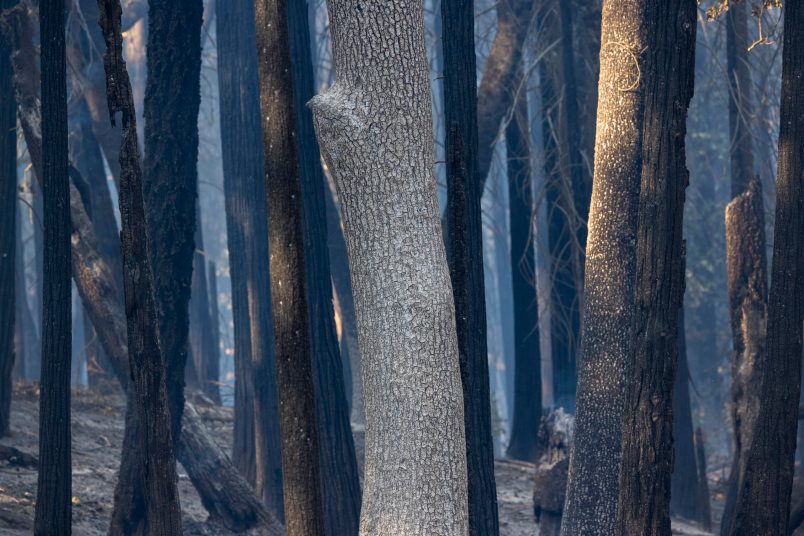This article is part of TPM Cafe, TPM’s home for opinion and news analysis. It first appeared at The Conversation.
Alongside a lingering global pandemic, the year 2021 was filled with climate disasters, some so intense they surprised even the scientists who study them.
Extreme rainstorms turned to raging flash floods that swept through mountain towns in Europe, killing over 200 people. Across Asia, excessive rainfall inundated wide areas and flooded subway stations in China. Heat waves shattered records in the Pacific Northwest, Europe and the Arctic. Wildfires swept through communities in California, Canada, Greece and Australia. And those were only a few of the extremes.
In the U.S. alone, damage from the biggest climate and weather disasters is expected to total well over US$100 billion in 2021.
Many of these extreme weather events have been linked to human-caused climate change, and they offer a glimpse of what to expect in a rapidly warming world.
In the U.S., something in particular stood out: a sharp national precipitation divide, with one side of the country too wet, the other too dry.
As a climate scientist, I study the impact of global warming on precipitation and the water cycle. Here’s what happened with precipitation in the U.S. in 2021 and why we’re likely to see similar scenarios in the future.
The east-west weather divide
The eastern U.S. weathered storm after storm in 2021. Record rainfall in Tennessee triggered deadly flash flooding in August. The remnants of Hurricane Ida merged with another front days after the hurricane hit Louisiana and became so intense they set rainfall records and flooded subway stations and basement apartments in New York and Pennsylvania, with devastating consequences. Severe storms hit several states with deadly tornadoes in December.
Almost the entire West, meanwhile, was in some stage of drought, helping to fuel wildfires that swept through forests and towns.
This kind of east-west weather divide can be enhanced by La Niña, a periodical phenomenon fueled by Pacific Ocean temperatures that tends to leave the Southwest drier than normal and the North and much of the eastern half of the U.S. wetter.
But something else is going on: Global warming fuels both dryness and extreme rainfall.

3 impacts of global warming on rainfall
Three things in particular happen to precipitation when the planet warms.
1) Global warming leads to more overall precipitation.
Higher temperature increases evaporation from Earth’s surface. It also increases the atmosphere’s capacity to hold moisture at a rate of about 7% per degree Celsius that the planet warms. With more moisture evaporating, global precipitation is expected to increase, but this increase is not uniform.
2) Global warming leads to more intense precipitation.
With higher temperature, more moisture is needed to reach the condensation level to form precipitation. As a result, light precipitation will be less common. But with more moisture in the atmosphere, when storm systems do develop, the increased humidity leads to heavier rainfall events.
In addition, storm systems are fueled by latent heat – the energy released into the atmosphere when water vapor condenses to liquid water. Increased moisture in the atmosphere also enhances latent heat in storm systems, increasing their intensity.
Research shows that both the frequency and intensity of heavy precipitation events has increased since the 1950s over most land areas.

3) Global warming tends to make wet places wetter and dry places drier.
Precipitation is not distributed evenly over the planet because of the global atmosphere circulation pattern. This global circulation brings moisture to places where winds come together, such as the tropical regions where we find most of the world’s rainforests, and away from places where winds diverge, such as the midlatitudes where most world’s deserts are located.
Assuming no significant changes in global wind patterns, increases in evaporation and moisture will mean more moisture is transported from dry areas to wet areas and into the storm tracks at higher latitudes. Global warming could also potentially change the global circulation pattern, causing a shift in the world’s wet and dry regions.

Mountains, moisture and the east-west divide
These dynamics are also affected by local conditions, such as the shape of the land, the types of plants on it and the presence of major water bodies.
The western U.S., with the exception of the West Coast, is dry in part because it lies in the rain shadow of mountains. The westerly wind from the Pacific Ocean is forced upward by the mountain ranges in the West. As it moves up, the air cools and precipitation forms on the windward side of the mountains. By the time the wind reaches the leeward side of the mountains, the moisture has already rained out. As the wind descends the mountains, the air warms up, further reducing the relative humidity.
Higher temperature in areas like these where the moisture supply is already limited means less humidity in the air, leading to less rain. Higher temperature and less precipitation would also reduce snow packs in the mountains and cause earlier melt in spring. All these changes are likely to increase aridity in the West.

The eastern U.S., on the other hand, receives abundant moisture from the North Atlantic and the Gulf of Mexico carried by the easterly trade wind. With abundant moisture supply, increasing temperature means more moisture in the atmosphere, leading to more precipitation and stronger storms.
This is what years of precipitation records show and what is projected for future precipitation based on climate models. Both show a decrease in annual precipitation in the West, likely meaning more long periods of drought, and an increase in the East with global warming.
Shuang-Ye Wu is a professor of geology and environmental geosciences at the University of Dayton.
This article is republished from The Conversation under a Creative Commons license. Read the original article.







Could have included some discussion on disruption of sea and air currents, black carbon, destruction of cryosphere, etc.
There are just too many aspects of AGW. That’s the problem with the problem.
For instance both the Pine Island Glacier and the Thwaits Glacier in Antarctica are cracking up as I write. Indicating that they are both unmoored from their grounding lines and have begun to accelerate into the ocean. This means a very significant sea level rise of at least 6feet is baked into the future even if we stopped emitting carbon today. 1 billion folks will become refugees.
Also too. Climate change will meet homelessness in Seattle next week with an extremely rare week long cold snap.
AGW related issues are already here but we have already surrendered to 2.4C.
Materialism is our death cult.
I am curious about the “more intense rain storms”. It seems to me that this would be a transitional phenomenon. Rain results from warm damp air confronting and mixing with cold air resulting in a a mix of air that is cooler and unable to keep the moisture. I can see that as climates become warmer there will be a period where colder air will be available at times, but over-all climate equilibrium will eventually come, and both the warm air and the cooler air will both be warmer. I think the results of this would be harder to predict as to wetter or drier over-all. But I also think more intense storms is a transitional thing.
The consensus I get from climate scientists (Arctic Sea Ice Blog) is that overall precipitation will decrease but the physics suggest that the storms will be more severe. Also too with the kinky jet stream the precipitation events will hang around for days rather than blow through in a few hours.
As to when we might attain a “new normal”, don’t hold your prevailing wind. A BOE (blue ocean event) will inevitably occur in the Arctic and result in a global atmospheric kerfuffle that will persist for centuries. Bringing a succession of extreme weather events.
Yes, many many aspects. There is a lot of discussion about how the pandemic is a big driver of current American politics, but the pandemic is also a product of human disruption of natural services. Perhaps not a cart-horse thing, but certainly a linkage of pandemics and climate disruption exists.